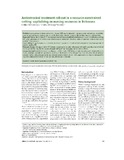Antiretroviral treatment roll-out in a resource-constrained setting: capitalizing on nursing resources in Botswana
Date
2007Author
Miles, K.
Clutterbuck, D.J.
Seitio, O.
Sebego, M.
Riley, A.
Publisher
Bulletin of the World Health Organization. http://www.scielosp.org/scielo.php?script=sci_serial&pid=0042-9686Type
Published ArticleMetadata
Show full item recordAbstract
Problem As programmes to deliver antiretroviral therapy (ART) are implemented in resource-constrained settings, the problem
becomes not how these programmes are going to be financed but who will be responsible for delivering and sustaining them.
Approach Physician-led models of HIV treatment and care that have evolved in industrialized countries are not replicable in settings
with a high prevalence of HIV infection and limited access to medical staff. Therefore, models of care need to make better use of
available human resources.
Local setting Using Botswana as an example, we discuss how nurses are underutilized in long-term clinical management of
patients requiring ART.
Relevant changes We argue that for ART-delivery programmes to be sustainable, nurses will need to provide a level of clinical
care for patients receiving this therapy, including prescribing ART and managing common adverse effects.
Lessons learned Practicalities involved in scaling up nurse-led models of ART delivery include overcoming political and professional
barriers, identifying educational requirements, agreeing on the limitations of nursing practice, developing clear referral pathways
between medical and nursing personnel, and developing mechanisms to monitor and supervise practice. Operational research is
required to demonstrate that such models are safe, effective and sustainable.

